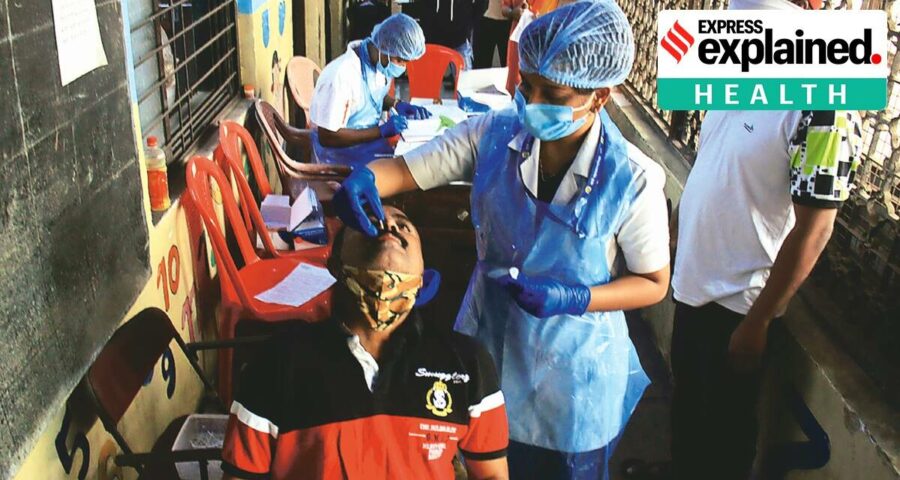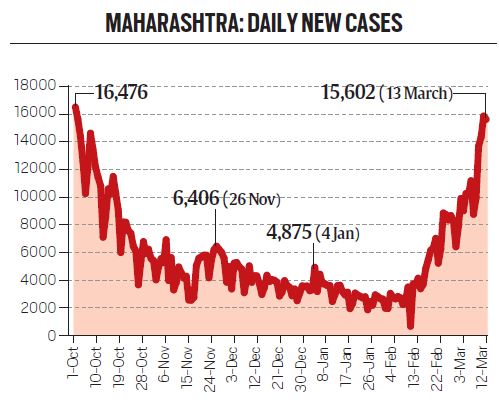If we look at the situation only in Maharashtra, the state is currently reporting around 16,000 cases per day. Looking at the present trends, it is likely that the state will very soon touch the 20,000-cases a day mark. The effort is to prevent that, but it does seem we are headed towards that figure in the next few days.
Is India witnessing a second wave of infections?
From what we are observing, it does appear to be a second wave. That is not an incorrect description. The magnitude and speed of the rise in new cases is in fact comparable to the first wave.
Is the pandemic headed towards a peak similar to the one in the first wave? Maharashtra, for instance, reported close to 25,000 cases in a day at its peak in September last year.
If we look at the situation only in Maharashtra, the state is currently reporting around 16,000 cases per day. Looking at the present trends, it is likely that the state will very soon touch the 20,000-cases a day mark. The effort is to prevent that, but it does seem we are headed towards that figure in the next few days.
But what is different from the first wave?
The most important difference is the fact that the virus circulating now appears to be much less virulent than earlier. This is evident from the fact that even though the cases are rising, the case fatality ratio, or CFR, has been declining. In Maharashtra, for example, the fatality rate in the last one month is less than 1%. That is quite a hopeful sign. While the increase in cases continue to be worrisome, at least people are not dying. Now we are monitoring the CFRs on a weekly basis, and except for three or four districts in Maharashtra, it is falling everywhere.
What is wrong with Maharashtra’s containment strategy?
There is nothing wrong. Epidemic curves are different in different places because of a variety of factors, including the geography, weather patterns and international connectivity. There is a very complex interplay of these reasons, and it is not always possible to predict these curves. We do not even fully understand why a certain state or country has taken a specific trajectory, very different from others. There are lots of variables to be taken into account, and not all of them are easily deterministic.
Would a return of lockdowns help?
I don’t think lockdown is the right strategy to contain the spread of the virus at this stage. Lockdown is basically a pause button. It had an important utility in the initial phases of the epidemic when we needed to prepare ourselves to deal with the crisis. It provided us time to upgrade our health infrastructure, increase the number of hospital beds, our laboratory network, equipment like oxygen beds and ventilators. But now that those systems are already in place, lockdown should have little role to play in the containment strategy. There are very large social and economic side-effects of a lockdown, which can turn out to be bigger problems than the virus itself.
A more effective strategy at this time is strengthened surveillance. This means we need to do more aggressive contact tracing, screening for symptoms at fever clinics, and monitoring of people who are in home isolation to ensure that they are following prescribed behaviour. For this, we need to activate as many field units as possible. 📣 Express Explained is now on Telegram. Click here to join our channel (@ieexplained) and stay updated with the latest
What about the role of vaccination?
Vaccination certainly has a very important role to play here. The results of serosurveys conducted by Indian Council of Medical Research has shown that in most places not more than 20-25% of the population has been infected by the virus. So only these many people would have attained immunity. Vaccination can rapidly increase the proportion of people immune to the disease, so that we quickly reach a stage where herd immunity starts to play its role.
But why is vaccination still being done in a phased manner? Why is it not opened up for everyone?
While the trials of vaccines have produced very encouraging results, we still have to be very careful about these. That is because we have data only for a short time. It is important to keep monitoring the impact of these vaccines on those who are receiving it. A very robust monitoring mechanism, what is known as AEFI surveillance, or adverse event following immunization, is being followed, wherein every adverse event is being carefully scrutinized and investigated. This is called pharmaco-vigilance. This is standard procedure whenever a new drug or vaccine is introduced.
That is also the reason why there is a lot of documentation required for vaccination right now. As we collect and analyse more and more data from this vaccination drive, we will be more assured about the safety and efficacy of these vaccines. In any case, within a month or two, the vaccination would be open for everyone. But initially, it was important to do it in a phased manner.
What about people who have already received complete dosage of vaccines? Do they still need to take precautions?
No vaccine is 100% effective. The Covid19 vaccines certainly are not. That means that, at an individual level, the risk of infection remains even after getting the vaccine, although the probability of this happening is very low. But there is another uncertainty. We do not know how long the immunity gained through the vaccines lasts. This is an open question to which we do not have an answer right now. Therefore, it is very strongly advised that people must adhere to Covid-appropriate behaviour even after receiving a vaccine.
How long would people have to live with masks?
This is difficult to say at this point. There are lots of variables that are unknown or uncertain. Emergence of new variants, the effectiveness of vaccines against them, the duration of immunity gained through vaccinations are all factors that would decide how long do we need to wear masks, practice physical distancing and follow Covid-appropriate behaviour.
Dr Awate interacted with The Indian Express team at an Idea Exchange programme in Pune
Source: Read Full Article



